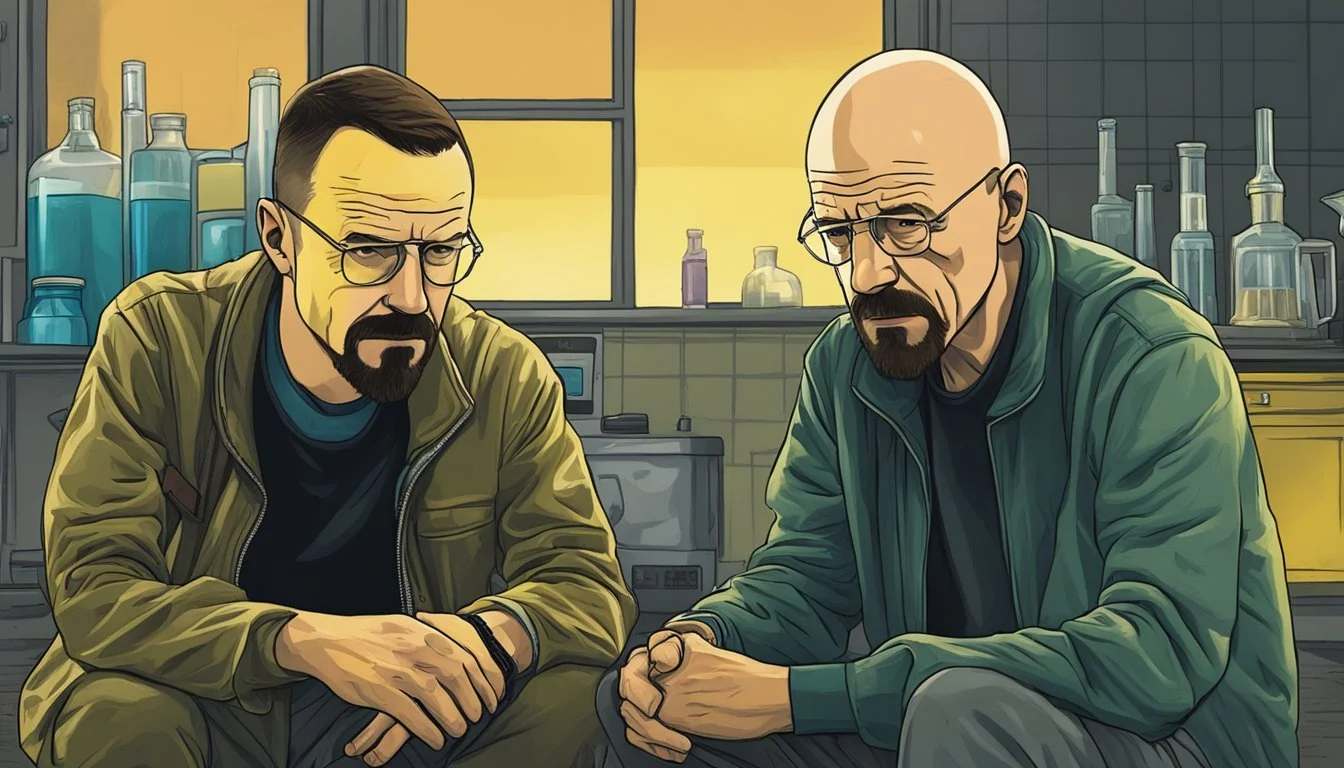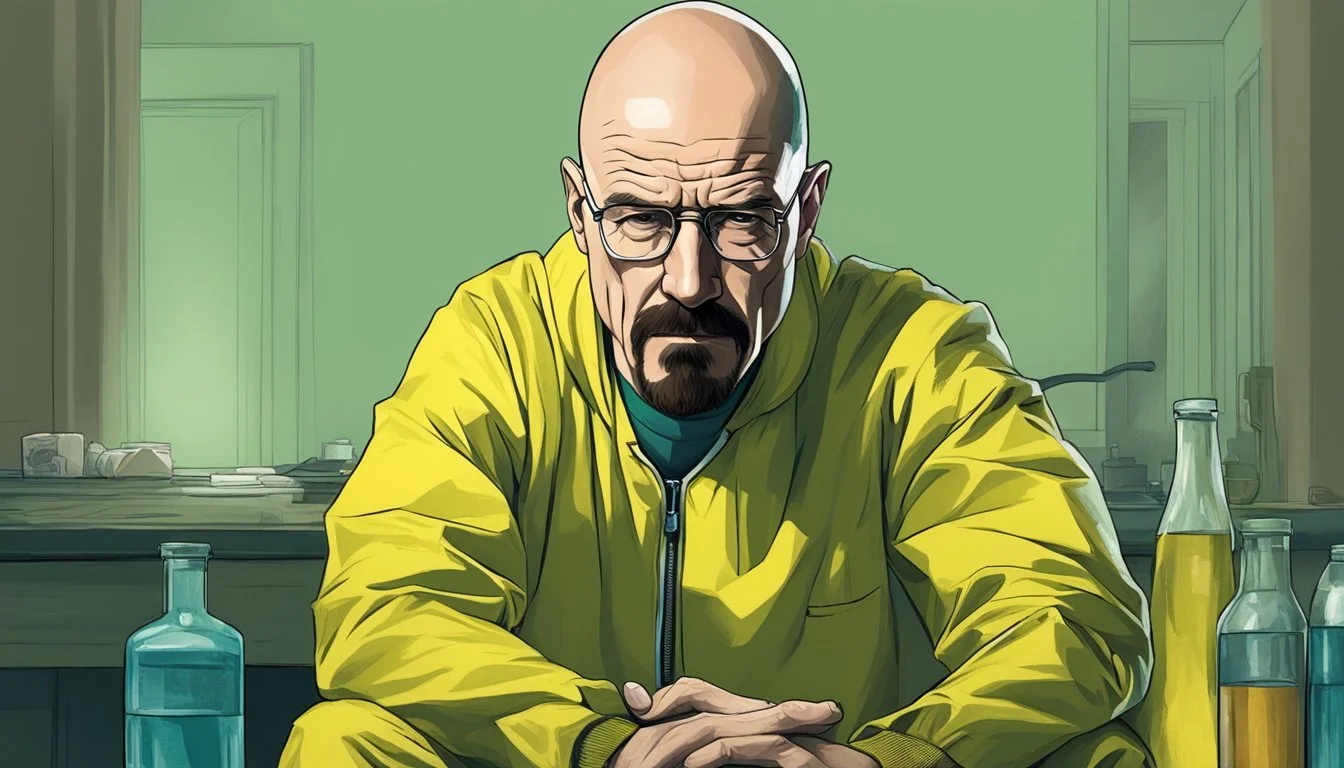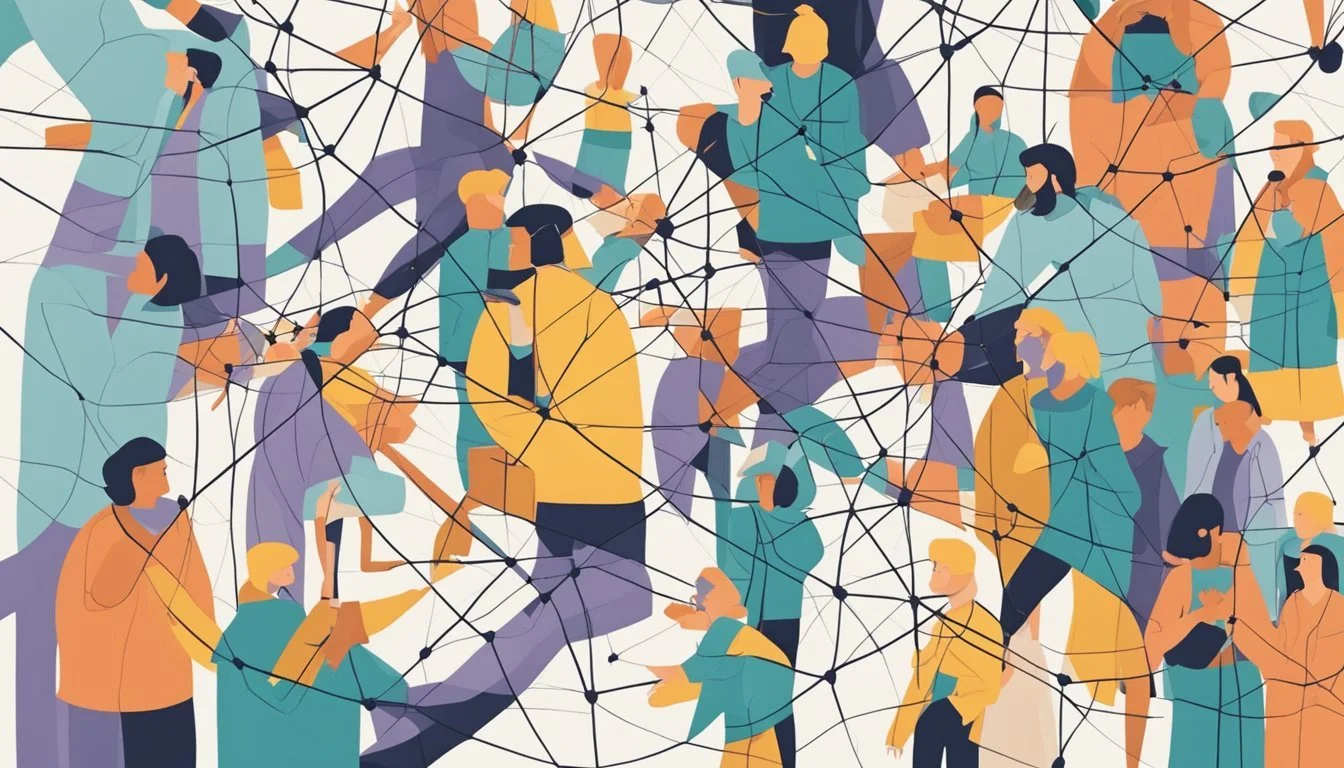The Psychology of Manipulation in Breaking Bad's Relationships
Power Dynamics and Moral Decay
Breaking Bad, the critically acclaimed AMC series created by Vince Gilligan, captivated audiences with its intricate exploration of human psychology and relationships. At the heart of the show lies a web of manipulation, power dynamics, and moral ambiguity that drives the narrative forward.
The complex relationships in Breaking Bad reflect the psychological toll of living a double life, as characters constantly navigate between their public personas and hidden agendas. Walter White's transformation from a mild-mannered chemistry teacher to a ruthless drug lord serves as the focal point for examining how manipulation shapes interactions and alters the moral compass of those involved.
The show's success can be attributed to its nuanced portrayal of characters grappling with guilt, fear, and ambition. By delving into the psychological motivations behind each character's actions, Breaking Bad offers a compelling study of how manipulation affects both the manipulator and the manipulated, blurring the lines between victim and perpetrator in a world where trust is a scarce commodity.
Walter White's Transformation
Walter White's journey from a mild-mannered high school chemistry teacher to the infamous drug kingpin Heisenberg is a study in psychological transformation. His evolution encompasses drastic changes in personality, morality, and relationships.
From High School Chemistry Teacher to 'Heisenberg'
Walter White begins as an underachieving chemistry teacher, struggling to make ends meet. His expertise in chemistry becomes the foundation for his entry into the methamphetamine trade. As he delves deeper into the criminal world, he adopts the alias "Heisenberg," named after the renowned physicist.
This alter ego allows Walter to separate his criminal activities from his family life. The name becomes synonymous with high-quality methamphetamine and a ruthless drug lord. Walter's transformation is marked by increased confidence, assertiveness, and a willingness to use violence to achieve his goals.
His methods become more sophisticated and his network expands, leading to conflicts with established drug cartels and law enforcement.
Cancer Diagnosis and the Drive for Control
Walter's terminal lung cancer diagnosis serves as the initial catalyst for his transformation. Faced with mortality and financial insecurity, he decides to use his chemistry skills to secure his family's future.
The diagnosis triggers a profound psychological shift:
Increased risk-taking behavior
A sense of urgency to accumulate wealth
Detachment from conventional morality
Walter's desire for control intensifies as he grapples with the unpredictability of his illness. His actions become increasingly calculated and manipulative, driven by a need to exert influence over his circumstances and those around him.
The Alter Ego and Moral Decline
As Heisenberg, Walter embraces a new identity that allows him to act without the constraints of his former self. This alter ego facilitates his moral decay, enabling him to rationalize increasingly unethical actions.
Key aspects of Walter's moral decline include:
Manipulation of friends and family
Willingness to commit murder
Prioritizing personal gain over others' well-being
The line between Walter White and Heisenberg blurs as the series progresses. His transformation challenges the concept of static personality, showcasing how circumstances and choices can fundamentally alter an individual's character.
Walter's journey from "Mr. Chips to Scarface" exemplifies the complex nature of moral decay and the psychology of power.
Interpersonal Dynamics and Manipulation
Breaking Bad's characters navigate complex relationships driven by power, deception, and emotional manipulation. The show explores how individuals use psychological tactics to influence others and justify their actions.
Power and Hierarchy in the Methamphetamine Trade
Walt's entry into the drug world exposes him to a strict hierarchy based on production skill and distribution networks. His scientific expertise quickly elevates his status, disrupting established power structures. This shift creates tension with figures like Tuco Salamanca and Gus Fring.
As Walt gains influence, he manipulates lower-level dealers and rivals. He exploits their weaknesses and leverages his product's quality to maintain control. The volatile nature of the meth trade amplifies power struggles, leading to betrayals and violence.
Walt's rise illustrates how quickly power dynamics can shift in criminal enterprises. His manipulation of the hierarchy showcases his growing comfort with unethical behavior.
Manipulation Tactics and Rationalization
Characters in Breaking Bad employ various manipulation tactics to achieve their goals. Walt often uses gaslighting to make Jesse doubt his own perceptions and memories. He presents false information or denies past events to maintain control over his partner.
Guilt-tripping is another common tactic. Walt manipulates his family's emotions by emphasizing his cancer diagnosis and desire to provide for them. This emotional leverage helps him justify his illegal activities.
Rationalization plays a crucial role in characters' decision-making. Walt repeatedly frames his choices as necessary for his family's well-being. This cognitive process allows him to engage in increasingly unethical acts while maintaining a positive self-image.
Emotional Blackmail and Cognitive Dissonance
Emotional blackmail features prominently in Breaking Bad's relationships. Characters threaten to withdraw love, support, or protection to coerce others into compliance. Walt uses this tactic with both his family and criminal associates.
These manipulative behaviors often create cognitive dissonance in the characters. They struggle to reconcile their self-perception with their actions. Jesse, for example, grapples with guilt over his involvement in the drug trade and its consequences.
The show explores how this dissonance can lead to psychological distress and erratic behavior. Characters may double down on their choices or seek ways to alleviate their guilt through acts of kindness or self-destructive behavior.
Breaking Bad's Narrative Structure
Breaking Bad's narrative structure weaves together complex character arcs, powerful symbolism, and intricate moral dilemmas. The show's storytelling techniques create a compelling and multi-layered viewing experience.
Storytelling through Character Development
Breaking Bad excels in character-driven storytelling. Walter White's transformation from a mild-mannered chemistry teacher to a ruthless drug kingpin forms the backbone of the narrative.
His descent into moral corruption is mirrored by Jesse Pinkman's struggle for redemption. These parallel journeys create tension and drive the plot forward.
Secondary characters like Skyler, Hank, and Gus Fring undergo significant changes. Their evolving relationships with Walt add depth to the story.
The show employs flashbacks to reveal crucial backstory elements. These glimpses into the past shed light on characters' motivations and decisions.
Symbolism and Foreshadowing in Breaking Bad
Breaking Bad uses visual symbolism to enhance its storytelling. Colors play a significant role in representing characters' states of mind and story arcs.
Key props and locations serve as powerful symbols. The iconic RV, for instance, represents both Walt's criminal enterprise and his deteriorating morality.
Foreshadowing is expertly woven throughout the series. Subtle hints and seemingly innocuous details often gain significance in later episodes.
The show's opening sequences frequently employ symbolic imagery. These cold opens set the tone for each episode and often contain clues about future events.
Narrative Mechanisms and Moral Dilemmas
Breaking Bad's narrative structure revolves around escalating moral dilemmas. Each decision Walt makes pushes him further into a web of lies and criminality.
The show employs narrative mechanisms like cliffhangers and time jumps to maintain tension. These techniques keep viewers engaged and heighten dramatic impact.
Breaking Bad challenges traditional notions of heroism by presenting Walt as an antihero. His actions blur the line between protagonist and antagonist.
The narrative explores the consequences of crossing moral boundaries. Characters face increasingly difficult choices as the story progresses.
Narrative twists and reversals of fortune keep the plot unpredictable. This creates a sense of unease and reflects the volatile world of drug trafficking.
Characters' Motivations and Moral Complexity
The characters in Breaking Bad grapple with complex motivations and ethical dilemmas that shape their actions and relationships. Their choices reveal the intricate interplay between personal desires, external pressures, and moral considerations.
Jesse Pinkman's Quest for Redemption
Jesse Pinkman's journey is marked by a constant struggle with guilt and a desire for redemption. His initial involvement in the drug trade stems from a misguided attempt to find purpose and success. As the series progresses, Jesse becomes increasingly aware of the harm caused by his actions.
This awareness fuels his efforts to make amends and find a way out of the criminal world. Jesse's relationship with children, particularly Andrea's son Brock, serves as a catalyst for his moral awakening. His attempts to protect and care for others highlight his capacity for empathy and his yearning for a more ethical life.
Jesse's internal conflict between his criminal activities and his growing conscience drives much of his character development. His struggles with addiction further complicate his path to redemption, illustrating the complex interplay between personal demons and moral choices.
Skyler White and the Burden of Knowledge
Skyler White's character arc revolves around the moral implications of becoming complicit in her husband's criminal activities. Initially unaware of Walter's illegal actions, Skyler faces a profound ethical dilemma when she discovers the truth.
Her decision to protect her family by remaining silent and eventually participating in money laundering showcases the blurred lines between right and wrong. Skyler's struggle with the burden of knowledge manifests in her strained relationships and deteriorating mental health.
As she becomes more entangled in Walter's world, Skyler grapples with her own moral compass. Her attempts to maintain a facade of normalcy for her children while dealing with the reality of her situation highlight the emotional toll of living a double life.
Walter White's Pride and Desperation
Walter White's transformation from a mild-mannered chemistry teacher to a ruthless drug lord is driven by a complex mix of pride, desperation, and a desire for control. His initial motivation to provide for his family after his cancer diagnosis quickly evolves into a quest for power and recognition.
Walter's pride in his intellectual abilities and resentment over past failures fuel his descent into criminality. His rationalization of increasingly unethical actions reveals the gradual erosion of his moral boundaries. The thrill of success and the intoxicating nature of power further cement his commitment to his new identity as Heisenberg.
As the series progresses, Walter's desperation to maintain his empire and legacy leads to more extreme measures. His manipulation of those around him, including Jesse and his own family, demonstrates the extent to which he is willing to compromise his relationships and ethical standards to achieve his goals.
Socioeconomic Elements and Crime
Breaking Bad explores the complex interplay between financial pressures, environmental factors, and criminal behavior. These elements shape the characters' choices and drive the narrative forward.
The Role of Financial Insecurity
Walter White's initial motivation stems from his dire financial situation. Faced with a cancer diagnosis and inadequate health insurance, he turns to cooking methamphetamine as a means of securing his family's future. This desperation highlights the impact of financial insecurity on decision-making.
The show portrays how lack of financial stability can push individuals towards illegal activities. Walter's transformation from a struggling high school teacher to a drug kingpin illustrates the allure of quick money in the criminal underworld.
As the series progresses, financial motivations evolve into greed and power-seeking behavior. The characters become entangled in a web of crime, finding it increasingly difficult to escape.
Impact of Environment and Circumstance
Albuquerque's socioeconomic landscape plays a crucial role in shaping the characters' paths. The city's drug trade provides opportunities for those seeking financial gain through illicit means.
The show depicts how environment influences criminal behavior:
Limited economic opportunities
Presence of established criminal networks
Easy access to drug manufacturing materials
Characters like Jesse Pinkman are products of their surroundings, having grown up in an environment where drug use and dealing are commonplace. This familiarity with the criminal world makes it easier for them to rationalize their actions.
The series also explores how changes in circumstances can lead law-abiding citizens to criminal behavior. Walter's cancer diagnosis serves as the catalyst for his descent into the drug trade.
Criminal Decline and Self-Destruction
As characters delve deeper into criminal activities, they experience a gradual decline in moral standards and personal relationships. The pursuit of power and money leads to self-destructive behavior.
Key aspects of this decline include:
Isolation from family and friends
Paranoia and distrust
Escalating violence and risk-taking
Walter's transformation into "Heisenberg" exemplifies this process. His initial goal of providing for his family becomes corrupted by greed and ego, leading to a complete moral breakdown.
The show portrays how involvement in the drug trade creates a cycle of violence and retribution. Characters find themselves trapped in a world where every action has potentially deadly consequences.
Psychological Aspects of Breaking Bad Characters
Breaking Bad's characters exhibit complex psychological traits shaped by their circumstances and choices. Their mental states and behaviors reveal profound insights into the human psyche under extreme pressure.
The Human Psyche under Duress
Walter White's transformation from a mild-mannered chemistry teacher to a ruthless drug lord exemplifies how stress can alter one's personality. His terminal cancer diagnosis acts as a catalyst, unleashing suppressed desires for power and recognition.
Jesse Pinkman's psychological journey contrasts with Walt's. Initially carefree, Jesse grapples with increasing trauma and guilt as the series progresses. His experiences in the drug world leave lasting scars on his psyche.
Skyler White's mental state evolves from shock and denial to complicity. Her struggle to maintain normalcy while confronting Walter's criminal activities highlights the psychological toll of living a double life.
Machiavellian Behaviors and Narcissism
Walter White displays classic Machiavellian traits as he manipulates those around him. His actions often stem from a narcissistic belief in his own superiority and entitlement.
Gus Fring embodies calculated Machiavellianism. His meticulously planned maneuvers and ability to maintain a facade demonstrate extreme emotional control and strategic thinking.
Saul Goodman's manipulative tactics, while less violent, showcase a different form of Machiavellianism. His moral flexibility and self-serving nature reflect a pragmatic approach to survival in a dangerous world.
Remorse and Empathy in Complex Relationships
Jesse Pinkman's character arc is marked by increasing remorse. His empathy for others, particularly children, sets him apart from many other characters in the series.
Hank Schrader's pursuit of Heisenberg is driven by a strong sense of justice. His empathy for victims clashes with his personal relationship with Walt, creating intense internal conflict.
Walter White's capacity for remorse diminishes as the series progresses. His occasional displays of empathy become increasingly rare, highlighting his psychological deterioration.
Marie Schrader's kleptomania and subsequent therapy sessions provide insight into compulsive behaviors and the struggle for emotional stability within the tumultuous world of Breaking Bad.
Cultural Impact and Legacy of Breaking Bad
Breaking Bad's influence extends far beyond television, shaping popular culture and academic discourse. The show's critical acclaim, innovative storytelling, and complex characters left an indelible mark on entertainment and society.
Critical Acclaim and Audience Response
Breaking Bad garnered widespread praise from critics and viewers alike. The series won 16 Emmy Awards, including four for Best Drama Series. Its final season achieved a rare 99/100 score on Metacritic.
Fans embraced the show's dark humor and moral ambiguity. Online communities dissected each episode, creating theories and memes that spread across social media platforms.
The character of Walter White became a cultural icon, sparking debates about morality and the nature of evil. Merchandise sales soared, with blue candy "meth" becoming a popular novelty item.
Influence on Popular Media and Academic Research
Breaking Bad raised the bar for television drama, inspiring a new wave of morally complex protagonists. Shows like Ozark and Narcos drew clear inspiration from its storytelling techniques.
The series sparked academic interest in fields such as chemistry, ethics, and criminal justice. Universities began offering courses analyzing the show's themes and cultural significance.
Breaking Bad's visual style influenced cinematography in both TV and film. Its use of time-lapse photography and unique color palettes became widely emulated.
Series Finale: 'Ozymandias' and Beyond
The penultimate episode "Ozymandias" is widely regarded as one of the greatest television episodes ever made. It garnered a perfect 10/10 rating on IMDb from over 150,000 users.
The finale drew 10.3 million viewers, a record for AMC. It received critical acclaim for its satisfying conclusion to Walter White's story arc.
Post-finale, Breaking Bad's legacy continued through the prequel series Better Call Saul and the sequel film El Camino. These expanded the show's universe while maintaining its high quality.
Conclusion
Breaking Bad masterfully portrays the psychology of manipulation in its complex web of relationships. The characters' transformations are driven by their choices, which often stem from a sense of responsibility or destiny.
Walter White's character arc exemplifies moral disengagement as he justifies increasingly unethical actions. His inner self gradually aligns with his criminal persona, leading to a profound moral decline.
Jesse Pinkman's journey highlights the role of addiction and loyalty in shaping relationships. His struggle with substance abuse makes him vulnerable to manipulation, while his misplaced loyalty to Walt blinds him to the toxic nature of their partnership.
The series explores how characters use manipulation to achieve their goals, often at the expense of others. This manipulation ranges from subtle emotional coercion to outright threats and violence.
Breaking Bad's relationships serve as a lens through which viewers can examine the human capacity for change, both positive and negative. The show demonstrates how external pressures and internal desires can push individuals to extremes, testing the limits of morality and self-preservation.




